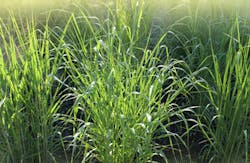There are environmental and economic benefits in producing ethanol from energy grasses such as miscanthus and switchgrass, according to a new study.
Researchers at the University of Illinois compared the yields and costs of producing cellulosic ethanol using miscanthus, switchgrass and corn stover, grown in high and low quality soils. Fast-growing miscanthus was found to be the clear winner, with higher yield and profit, particularly when grown in poor-quality soil. It also outperformed switchgrass and corn stover in its ability to reduce greenhouse gas (GHG) emissions.
"One of the reasons for interest in these second-generation cellulosic feedstocks is that if they can be grown on low-quality soil, they wouldn't compete for land with food crops, such as corn," explained University of Illinois agricultural economist Madhu Khanna, who co-authored the study with a team of economists and environmental and crop scientists from the university's Energy Biosciences Institute. "This study shows that although miscanthus yield was slightly lower on marginal, low-quality land, a farmer would have an economic incentive to grow miscanthus on the lower quality land first rather than diverting their most productive cropland from growing corn."
Compared to gasoline, the greenhouse gas savings from miscanthus-based ethanol ranged between 130 percent and 156 percent, and that from switchgrass ranged between 97 percent and 135 percent. The corresponding range for corn stover was 57 percent to 95 percent, putting it marginally below the threshold of at least 60 percent for biofuels classified as cellulosic biofuels under the Renewable Fuels Standard, the authors said in an article published in Environmental Science and Technology.
"It's tempting to use corn stover because it's already there — farmers who grow corn don't have to plant another crop to produce biofuel feedstock," Khanna said. "But in some cases corn stover is only about 59 percent cleaner than gasoline while miscanthus is about 140 percent cleaner. So if we want to reduce greenhouse gas emissions and lower the carbon intensity of our fuel, energy grasses such as miscanthus and switchgrass are going to result in the biggest reductions, not corn stover."
